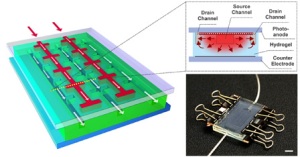To understand how solar cells heal themselves, look no further than the nearest tree leaf or the back of your hand.
 The design of NC State’s regenerative solar cell mimics nature by use of microfluidic channels.
The design of NC State’s regenerative solar cell mimics nature by use of microfluidic channels.
The “branching” vascular channels that circulate life-sustaining nutrients throughout leaves and hands serve as the inspiration for solar cells that can restore themselves efficiently and inexpensively.
In a new paper, North Carolina State University researchers Orlin Velev and Hyung-Jun Koo show that creating solar cell devices with channels that mimic organic vascular systems can effectively reinvigorate solar cells whose performance deteriorates due to degradation by the sun’s ultraviolet rays. Solar cells that are based on organic systems hold the potential to be less expensive and more environmentally friendly than silicon-based solar cells, the current industry standard.
The nature-mimicking devices are a type of dye-sensitized solar cells (DSSCs), composed of a water-based gel core, electrodes, and inexpensive, light-sensitive, organic dye molecules that capture light and generate electric current. However, the dye molecules that get “excited” by the sun’s rays to produce electricity eventually degrade and lose efficiency, Velev says, and thus need to be replenished to reboot the device’s effectiveness in harnessing the power of the sun.
“Organic material in DSSCs tends to degrade, so we looked to nature to solve the problem,” Velev said. “We considered how the branched network in a leaf maintains water and nutrient levels throughout the leaf. Our microchannel solar cell design works in a similar way. Photovoltaic cells rendered ineffective by high intensities of ultraviolet rays were regenerated by pumping fresh dye into the channels while cycling the exhausted dye out of the cell. This process restores the device’s effectiveness in producing electricity over multiple cycles.”
Velev, Invista Professor of Chemical and Biomolecular Engineering at NC State and the lead author of a paper in Scientific Reports describing the research, adds that the new gel-microfluidic cell design was tested against other designs, and that branched channel networks similar to the ones found in nature worked most effectively.
Study co-author Dr. Hyung-Jun Koo is a former NC State Ph.D. student who is now a postdoctoral researcher at the University of Illinois. The study was funded by the National Science Foundation and the U.S. Department of Energy.
Koo and Velev reported earlier a new type of biomimetic hydrogel solar cell.